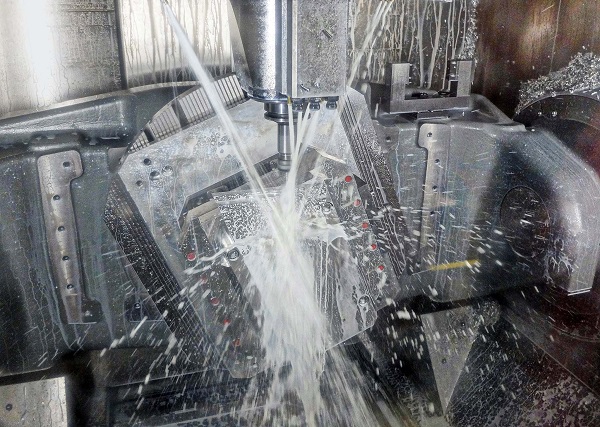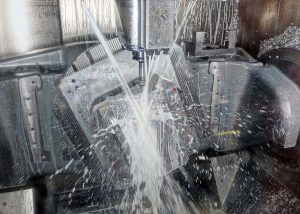The triggering in March of Article 50, formalising the two-year process for the UK to leave the European Union, has led some economic experts to predict a slowdown in growth and a general contraction within the sector. Others, no doubt fuelled by the fall in value of Sterling and its positive impact (to date) on exports, are more bullish and confident that UK manufacturing is more resilient than was originally thought.
With so many competing, and often conflicting, views of what could happen in the future, numerous UK companies, rather than waiting and “hoping for the best”, are taking matters into their own hands. Many are investing in their manufacturing plant, equipment, processes, systems and people, and strengthening their supply chain relationships to make themselves better prepared for the future and better positioned to capitalise on opportunities in a post-Brexit world.
One such company is subcontract specialist Aerotech Precision Manufacturing. Based in Poole, the company recently invested in a Doosan VCF 850LSR five-axis machining centre supplied by Mills CNC.
Aerotech, established in 1990, manufactures and supplies high-precision complex components and assemblies for the aerospace, defence, medical and energy sectors, as well as parts for packaging equipment and machines. Components machined by the company vary considerably and include prototypes and one-offs through to small-medium batch production.
A significant proportion of Aerotech’s work is in highly regulated markets and the company, not surprisingly, has invested heavily in ensuring it has the correct accreditations and certifications to operate and grow within these sectors, such as AS9100 (Rev C), ISO 9001, ISO 14001 and Fit4Nuclear.
Aerotech prides itself on the quality of the parts it supplies and adopts a ‘right first time, every time’ approach. The company also invests significant resources into both achieving, and often exceeding, customers’ tight delivery deadlines.
The emphasis on quality, lead-time fulfilment and cost competitiveness explains, to a large extent, the company’s recent investment in the Doosan VCF 850LSR.
“We operate in highly competitive global markets and, as such, you simply cannot afford to stand still,” says business development manager Aaron Houston. “As a consequence, we regularly audit and review our engineering and technical capacity and capabilities, benchmarking where we are against where we need to be. If there’s any disconnect between the two, we make strategic investments in the latest technology to bridge the gap.”
As part of the company’s continuous improvement programme, Aerotech made the decision to replace one of its existing large-capacity three-axis machines with a new five-axis machining centre. The investment was intended to help the company reduce job set-up times and part cycle times via adopting a one-hit machining strategy and, in so doing, improve its productivity and process reliability.
Explains Aerotech director Allan Redfern: “Although we decided on the five-axis machine tool route, there are so many different types and models available that we made sure we gave ourselves sufficient time to investigate the market thoroughly and thus ensure we selected the right machine for our requirements.”
To a large extent, the sectors served, materials used and type and complexity of components machined by Aerotech, narrowed the choice down to a large-capacity five-axis machine equipped with a Heidenhain control and swarf evacuation/chip management system. However, the machine also needed to deliver excellent cutting performance by maintaining high volumetric accuracies in roughing operations and guaranteeing high surface finishes, while enabling the company to produce parts using three-axis, 4+1 and full five-axis simultaneous machining.
“We had previously invested in a Doosan Puma 480L lathe from Mills CNC in 2013, and were impressed with its reliability and performance, as well as Mills’ aftersales service and support,” says Redfern. “As part of our five-axis machine tool selection process we attended a Mills open house and visited the company’s stand at an exhibition. On both occasions we were able to see the VCF 850LSR in action, and to talk to Mills’ sales and engineering staff about the machine and our plans.”
The moving-column VCF 850LSR has X-, Y- and Z-axis travels of 3000 x 850 x 800 mm, a B-axis (±110°) built-in ‘swivelling head’ milling spindle (32 kW/12,000 rpm) and an 800 mm diameter rotary table integrated into the machine’s 3500 x 870 mm long bed.
Doosan’s VCF 850LSR also features roller LM linear guideways, a 60-position servo-driven chain-type ATC, the Big Plus face and taper tool shank configuration and on-board cooling systems that help minimise thermal displacement during long production runs.
“The VCF 850LSR represents a sound investment, and is being used to machine complex, high-precision components for aerospace, defence and nuclear sector customers,” says Redfern. “One of the components being machined is used in advanced, remotely operated underwater vehicles [ROVs] used in the detection, assessment and destruction of sea mines.
“The components are made from aerospace grade aluminium alloy and machined from solid, first on our lathes and then four-/five-axis machined on the VCF 850LSR,” he adds. “Components are rough-machined in the first instance, which requires significant high-accuracy stock removal, before being finish-machined to realise a Ra 0.4 surface finish. Since machining these parts on the new Doosan machine, cycle times have been reduced dramatically.”
Now, a few months after installation, the VCF 850LSR is, naturally enough, taking on more and more work as Aerotech directors and managers become increasingly familiar with the machine, its capabilities and potential. The VCF 850LSR has also become a focal point for customers and prospects visiting Aerotech’s 2500 sq m facility.
“When visitors see the machine up close and in action, they are impressed,” concludes Houston. “The VCF 850LSR provides them with confidence and the certainty that Aerotech can achieve the part quality and lead times they demand. With advanced machining technologies such as the Doosan five-axis machining centre, we are prepared for most, if not all, eventualities in these challenging times.”
For further information
www.millscnc.co.uk















